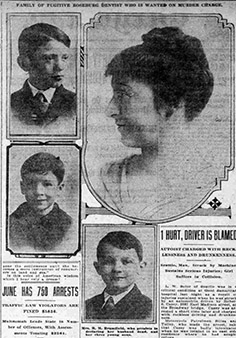ROSEBURG, DOUGLAS COUNTY; 1921:
Dynamite dentist killed, mailed out panties, fled
Audio version: Download MP3 or use controls below:
|

Brought in to identify the corpse, Brumfield’s “widow” (who is never identified by name in the newspapers) tearfully identified the body as his. She remained adamant in claiming it was his corpse for weeks afterward. But everyone else who looked at it — those who knew both men, at any rate — said it was unquestionably Russell. Further investigating the crime scene, the sheriff found a large pool of blood and rifle cartridge cases in the road where the two boys had heard the gunshots. They found more blood just off the road by the river, where they deduced the posthumous dental operation had been done. And they learned another bit of especially damning evidence from witnesses at the train yard. In Oakland, a hobo in overalls bearing a strong resemblance to the doctor had been caught trying to sneak a ride on the blind baggage car of a northbound passenger train. Ordered off the car, the hobo had gone to the ticket window, bought a passenger ticket, boarded the same train, and promptly entered the lavatory. He’d emerged a few minutes later wearing a new brown suit, the overalls wadded up in his hand, and ridden on to Eugene. Other bits of evidence didn’t seem to add up to much, but were extremely puzzling. The day before the explosion, with the help of a young dark-haired woman whom nobody had ever seen before (nor ever saw again), Brumfield had purchased some pink silk panties and other sexy lingerie; then he’d boxed them up and driven to the post office in Myrtle Point, where he was not known by sight. He asked to have the box shipped to Calgary; and, when the postal clerk told him it couldn’t be sent across the border, he settled for Seattle, saying that “Mrs. Norman Whitney” would call for the package in a couple weeks. This prompted the sheriff to issue a warning for everyone to be on the lookout for a tall, butch-looking woman traveling north by train. Nothing came of this; if cross-dressing was in Brumfield’s plans, he must have changed them. But this box of silk panties was to play a very significant role in his story later.
III.By June 15, news of this spectacular dynamite murder had been splashed all over the front pages of every newspaper in the state — the full gory details, breathlessly recounted, with Brumfield’s name in the headlines. The early stories also mentioned that he might be dressed in drag — information that could only have come from discovery of the box of sexy lingerie he’d tried to mail to Calgary the day before the murder. From this, perhaps Brumfield deduced that his northbound plans had been figured out; in any case, he was next seen in the company of an Army man, headed out into eastern Oregon. Reports subsequently came in from LaPine, Redmond, and Silver Lake, among other places. A touring car with Oregon plates found abandoned in Spokane with an semiautomatic shotgun and a “.38-caliber rifle” inside, along with part of a soldier’s uniform, was suspected of some connection. Dr. R.B. Shoemaker, a Roseburg physician on a road trip with his father to Crater Lake, claimed to have seen Brumfield speeding by them in an automobile south of Bend. There was even a report that Brumfield had taken up highway robbery, after a man who held up several members on a Mazama Club outing near Diamond Lake was “positively” identified as Roseburg’s most notorious ex-dentist. Meanwhile, back home in Roseburg, a chimney sweep stopped to pick up some litter by the roadside near the crime scene and found that one large can contained a human hand and a human foot — from two different people, a man’s hand and a woman’s foot — that had been apparently preserved in formaldehyde. Police investigated, and found the body parts were unrelated to the Brumfield case — and with that, the newspaper reporters covering the case moved on to other topics. One wonders if anyone ever got around to explaining these weird and sinister roadside discoveries; if they did, apparently their story wasn’t deemed newsworthy. But finally, on August 12, after just shy of a month on the lam, word came in from Calgary: Dr. Brumfield was in custody, and on his way back to Roseburg to face the music.
THE ARREST HAPPENED as a result of Brumfield trying to recover the box of sexy lingerie that he’d tried to mail to “Mrs. Norman Whitney” in Calgary. By now he had made his way to Calgary, and once there — under the name of Norman Whitney — settled into a job as a ranch hand. But then, for some reason, he thought it would be safe to ask the Seattle post office to forward the box of panties that he’d mailed to “Mrs. Norman” the day before the murder. If he’d been reading the newspapers, he would have known better. But if he wasn’t, the Post Office employees were; so when “Norman Whitney” called them up and asked them to forward “his wife’s package” to him, they forwarded his request to the police … and a day or two later, as “Whitney” was finishing up his plowing for the day and preparing to put the horses up in the barn, an officer from the Calgary Police Department stepped out behind him, pistol out and held low in his hand. “Hello, Doc,” he said. “What are you doing here?” (This story is Part One of a two-part series on Dr. Brumfield. You can continue reading Part Two here.)
|
Background image is an aerial postcard view of Haystack Rock and Cannon Beach, from a postcard printed circa 1950.
Scroll sideways to move the article aside for a better view.
Looking for more?
On our Sortable Master Directory you can search by keywords, locations, or historical timeframes. Hover your mouse over the headlines to read the first few paragraphs (or a summary of the story) in a pop-up box.
... or ...

©2008-2020 by Finn J.D. John. Copyright assertion does not apply to assets that are in the public domain or are used by permission.


